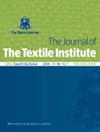循环荷载对土工织物加筋公路砂覆黏土模型的影响
IF 1.5
4区 工程技术
Q2 MATERIALS SCIENCE, TEXTILES
引用次数: 0
摘要
摘要本研究探讨了未处理/处理编织/非织造椰壳土工布在非铺装道路上的应用潜力。为此,在未浸水/浸水条件下,将未经处理/处理的纤维土工布放置在界面处,并在试验罐中对粘土层上的砂层进行室内循环荷载试验。研究结果表明,未处理/处理机织椰壳土工布加固模型的性能优于未处理/处理非织造椰壳土工布加固模型。此外,与浸泡状态相比,未浸泡/处理的编织和非织造椰壳土工布增强模型在未浸泡状态下的塑性变形改善更好。未经处理/处理的编织/无纺布土工布放置在粘土上的砂层界面时,可以减少未铺设道路的塑性变形,特别是在车辙深度高的情况下,因为塑性变形的改善可以达到更大的变形。关键词:编织椰壳土工布;非织造椰壳土工布;化学处理;循环荷载;本文章由计算机程序翻译,如有差异,请以英文原文为准。
Effects of cyclic loading on sand overlaying clay model of unpaved roads reinforced with untreated/treated coir geotextiles
AbstractThe current study examined the application potential of the untreated/treated woven/non-woven coir geotextile on unpaved roads. For this, untreated/treated coir geotextiles were positioned at the interface under the unsoaked/soaked condition, and laboratory cyclic load tests were done in a test tank for the sand layer overlying the clay layer. The results of the study showed that models reinforced with untreated/treated woven coir geotextiles are better than the models with untreated/treated non-woven coir geotextiles. Furthermore, in comparison to the soaked condition, models reinforced with untreated/treated woven and non-woven coir geotextiles show better improvement in plastic deformation in the unsoaked condition. When placed at the interface of the sand layer overlying clay, untreated/treated woven/non-woven coir geotextiles can reduce plastic deformation in unpaved roads, especially in situations where the rut depth is high, as the improvement in plastic deformation was realised up to larger deformation.Keywords: Woven coir geotextilesnon-woven coir geotextileschemical treatmentcyclic loadingunpaved roadsoakedunsoaked Disclosure statementNo potential conflict of interest was reported by the author.
求助全文
通过发布文献求助,成功后即可免费获取论文全文。
去求助
来源期刊

Journal of the Textile Institute
工程技术-材料科学:纺织
CiteScore
4.20
自引率
5.90%
发文量
149
审稿时长
1.0 months
期刊介绍:
The Journal of The Textile Institute welcomes papers concerning research and innovation, reflecting the professional interests of the Textile Institute in science, engineering, economics, management and design related to the textile industry and the use of fibres in consumer and engineering applications. Papers may encompass anything in the range of textile activities, from fibre production through textile processes and machines, to the design, marketing and use of products. Papers may also report fundamental theoretical or experimental investigations, including materials science topics in nanotechnology and smart materials, practical or commercial industrial studies and may relate to technical, economic, aesthetic, social or historical aspects of textiles and the textile industry.
All published research articles in The Journal of The Textile Institute have undergone rigorous peer review, based on initial editor screening and anonymized refereeing by two expert referees.
 求助内容:
求助内容: 应助结果提醒方式:
应助结果提醒方式:


